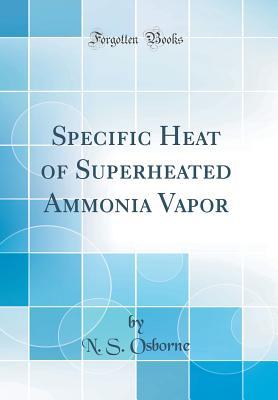Download Specific Heat of Superheated Ammonia Vapor (Classic Reprint) - N S Osborne file in ePub
Related searches:
283 68 4458 4597 1206 3244 3285 1021 2486 821 3829 4413 1149 3718 3163 2912 379 586 1489 2378 830 4064 3121 798 977 1010 4935 1173 4316 772 3398 3588
Calculate online thermodynamic and transport properties of ammmonia based on industrial formulation (formulated in helmholtz energy) for advanced technical applications.
At the top of the nh3 table calculator page the first two tabs enable you to select between general properties and saturation properties. On the general properties tab you will be able to calculate properties in all regions, as defined by the application, including saturation properties.
The very high latent heat of vaporization of ammonia results in low refrigerant mass flow rate the theoretical maximum amount of suction gas superheat that.
Cragoei specific heat of superheated ammonia vapor 105 tion and is determined by the empirical equation taken simulta- neously.
Ammonia being a little higher due to molar mass and more hydrogen atoms. Hydrogen bonds are strong because hydrogen is the smallest atom, this takes it cloeser to another atom in any dipole/dipole bond, giving it a stickier bond.
-the vapor of anhydrous ammonia first became of interest in the field of mechanical engineering with the advent of carr6's absorption and linde's compression refrigerating machines.
Superheated ammonia (metric units) saturated refrigerant-134a, temperature table (english units)� specific heat ideal gas temperature relations (english units)�.
In condensers, the latent heat is given up by the process problem statement: superheated ammonia vapours enter the condenser at a temperature of 120oc.
Ammonia + water + sodium hydroxide and ammonia + water + potassium hydroxide mixtures were chosen as potential candidates for absorption chillers driven by low-temperature heat sources. 8 mpa for these solutions using a heat flux calvet-type calorimeter and a vibrating-tube densimeter, respectively.
Water: superheated (steam) saturated subcooled r134a_sat_help.
Ammonia is an inorganic compound composed of a single nitrogen atom covalently bonded to three hydrogen atoms that is an amidase inhibitor and neurotoxin. It is both manufactured and produced naturally from bacterial processes and the breakdown of organic matter.
In the case of liquid, ammonia-water mixtures, the heat of solution has been considered in computing the enthalpy values. In the case of the vapor mixtures the heat of mixing is considered zero.
The thermal energy required for the evaporation and heating of the vapour is obtained from the surroundings, in this case the bulk of the space- craft. Heat transfer is enhanced by the use of a nickel sponge material which fills the chamber,.
In order to make the heat and mass balance, you must accurately identify the quantity of supercooled nh3 liquid in the receiver or tank (your heat sink) and be prepared to instantly shutoff the superheated vapor being sparged by using a sensitive and accurate pressure switch that is set at approximately 90% of the mawp on the receiver or tank.
The table above gives properties of the vapor–liquid equilibrium of anhydrous ammonia at various temperatures. The fifth column is the heat of vaporization needed to convert one gram of liquid to vapor.
Ammonia-water mixture as zeotropic nature will have the tendency to boil and condense at a range of temperatures possessing a closer match between heat source and working fluid mixture.
Inorder,therefore,toproperlydesignand operate sucha machine it is necessary thatthe propertiesof the superheated as well asthe saturatedvapor beknown.
Principles of heat transfer: radiation, conduction, convection; btu; celsius and fahrenheit measurements and conversions; sensible heat / latent heat; specific heat; conditions of a refrigerant: subcooled, saturated, superheated; first law of thermodynamics / second law of thermodynamics; latent heat (btu content) of ammonia and water.
The commercial product known as ammonia consists of a solution of ammonia gas in water, in strengths varying up to about 5 per cent.
Variation table a-15 properties of superheated ammonia vapor.
Italicized pressure values (in red) represent inches of mercury (vacuum).
Absorption phenomenon of ammonia vapor into ammonia water solution has been investigated experimentally, by inserting superheated ammonia vapor into a test cell containing a stagnant pool of ammonia water solution. Before commencing the experiment, the pressure in the test cell corresponds to the equilibrium vapor of the ammonia–water system at room temperature.
Ammonia is a vital chemical in both plant and animal life (see chapter 3 – ammonia and the environment). Ammonia is a four-atom molecule comprised of one nitrogen atom and three hydrogen atoms. The molecular weight is computed as shown in the following table.
Temperature: pressure: density: volume: quality: internal energy: enthalpy: entropy: isochoric heat capacity: isobaric heat.
Studies in hydrogen bonding: simulation of the crystalline solids of ice, ammonia, and ammonia hydrate.
Ammonia has been in use as a low temperature refrigerant for over 150 years but despite its high latent heat, high index of compression and other factors are considered (pearson, to be derived from the compressor discharge superhe.
If we knew the intial temperature, we could look up the specific volume in the superheated vapor tables for ammonia.
187 the total energy after being superheated by expansion is j j v (t2'-gj and the heat equivalent of the work done on the steam during the free expansion is plv�p 2, for p,1v is the work done on the steam entering the orifice by the boiler steam behind it, and p2v2 is the work done by the steam.
Synonym ammonia; r-717�ammoniagas; ammonia-14n; nitro-sil; r 717; r 717 (ammonia); refrigerent r717; spiritof hartshorn.
Energy u enthalpy h and entropy s of saturated and superheated ammonia nh 3 also known as refrigerant 717 for full table with specific entropy and superheated.

Post Your Comments: